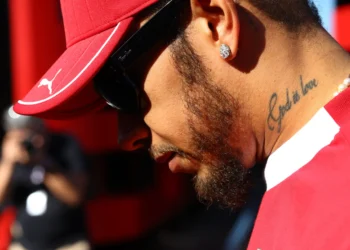As life in the fast lane of NASCAR mirrors the need for constant adaptation, Samantha Busch, wife to two-time NASCAR Cup Series champion Kyle Busch, is a testament to this principle – not on the racetrack, but in her personal health journey. After breaking a dietary pattern of 25 years to combat alopecia, Samantha is once more re-engineering her wellness approach, this time with a focus on recovery in her fitness routine.
Samantha’s transformative shift in lifestyle follows hot on the heels of her radical dietary overhaul in December 2024. She sparked headlines when she reintroduced red meat into her diet after abstaining for a quarter-century. Coupled with medical treatments, the dietary change helped her regain her hair lost to alopecia, a condition she started grappling with in 2022. With her hair health on the mend, Samantha has shifted focus to another facet of wellness, marrying intense training with sufficient recovery.
The lifestyle blogger and mother of two has pivoted to strength training as her fundamental fitness approach, a departure from the high-intensity workouts that previously ruled her routine. In a recent Instagram post, Samantha disclosed, “I strength train 4-5 days a week”, underlining the shift in her exercise philosophy that now emphasizes muscle-building rather than relentless cardio.
Challenging the prevailing misconception that effective fitness mandates daily high-intensity sessions, Samantha declared, “Rest Days Aren’t Lazy—They’re essential!” She admitted to her followers about her past struggle with guilt on her off days, slowly realizing that these rest days are when the body truly progresses – through recovery, rebuilding, and progress. This candid confession resonates with many fitness enthusiasts who similarly grapple with guilt during necessary recovery periods.
Samantha’s balanced fitness approach dovetails with the holistic health strategy she adopted to fight alopecia. In her Instagram post, she illustrated how her new training regimen has helped balance her cortisol levels, hormones, and overall well-being, in addition to pivotal dietary and lifestyle changes. This ties in with her previous commitment to incorporate “good fats” and aim for “about 150 grams of protein per day” through foods like red meat, olive oil, salmon, avocados, and nuts, dietary choices that bolster both her hair health and fitness objectives.
For Samantha, rest days aren’t solely about physical recovery; they also provide mental rejuvenation. “On recovery days, I love getting outside, soaking up the sunshine, and moving in a way that feels good,” she shared, acknowledging that the impact on her “sleep, energy, and mindset has been a game-changer.” This holistic approach to health underscores the growing recognition of the symbiosis between physical training, nutrition, and recovery.
Samantha’s public health transformations belie a deeper personal journey that has influenced her approach to wellness and community. Since 2015, she and her husband Kyle have struggled with infertility, undergoing six IVF treatments and enduring multiple miscarriages. Samantha’s courage is evident in her approach to both alopecia treatment and fitness transformation, confronting every health challenge head-on.
In response to their personal struggle, Samantha and Kyle Busch established the Bundle of Joy Fund in 2015. The couple has since distributed nearly $2 million through 131 grants to assist couples struggling with infertility, resulting in the birth of 100 babies. Samantha’s philanthropic initiatives align with her educational content about health and wellness, aiming to break societal barriers and provide valuable assistance to individuals with similar conditions.
Whether it’s incorporating red meat into her diet for alopecia treatment or acknowledging the importance of rest days for fitness, Samantha Busch epitomizes the necessity for ongoing adaptation in life. By sharing her trials in diet, training, and family planning, she has built an international legacy that extends beyond the NASCAR competition. She underscores through her personal transformations that body awareness, flexible decision-making, and acceptance of personal weakness are key to achieving wellness, often on par with professional racing success.










